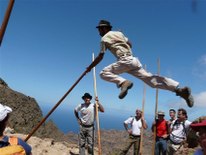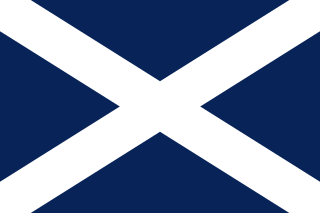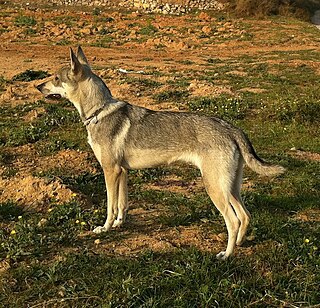
The shepherd's leap (Spanish : salto del pastor) is a folk sport practised throughout the Canary Islands.

The shepherd's leap (Spanish : salto del pastor) is a folk sport practised throughout the Canary Islands.
The origins of the shepherd's leap may date back to the Guanches, the aboriginal inhabitants of the islands prior to the Castilian conquest period of the early 15th century. Canarian shepherds required a specialised means of transporting themselves safely across ravines and down steep embankments, and settled on the use of long wooden poles known as lanza or garrote. These poles are fitted with sharp metal points called regatón.[ citation needed ]
Salto del pastor practitioners have developed a wide range of techniques to facilitate quick and agile movement across extremely difficult and dangerous terrain. These techniques range from pole-vaulting across crevices to the "dead drop" in which the practitioner leaps into space from heights of up to eight metres (26 ft), jamming the pole into the ground below and then sliding down the pole. There are many other types of leaps, depending on the nature of the obstacle to be cleared. Some of these are sufficiently dangerous to have given rise to legends such as the salto del enamorado (lover's leap) and the salto de media luna (half moon leap).[ citation needed ]
As the shepherd's leap has now developed into a folk-sport, the pole is also used in competitive events, which include climbing up and jumping over walls, speedy descents down steep rocks, precision leaps, and acrobatic feats.[ citation needed ]
The lance of the shepherd is part of the iconographic attributes of Saint Peter of Saint Joseph de Betancur, who is the first saint of the Canary Islands. This is because said Saint was a pastor or peasant before becoming a missionary in Guatemala. [1]

The Canary Islands, also known informally as the Canaries, are a Spanish region, autonomous community and archipelago in the Atlantic Ocean. At their closest point to the African mainland, they are 100 kilometres west of Morocco. They are the southernmost of the autonomous communities of Spain. The islands have a population of 2.2 million people and are the most populous special territory of the European Union.

Tenerife is the largest and most populous island of the Canary Islands. It is home to 42.9% of the total population of the archipelago. With a land area of 2,034.38 square kilometres (785.48 sq mi) and a population of 948,815 inhabitants as of January 2023, it is also the most populous island of Spain and of Macaronesia.

Stick-fighting, stickfighting, or stick fighting, is a variety of martial arts which use simple long, slender, blunt, hand-held, generally wooden "sticks" for fighting, such as a gun staff, bō, jō, walking stick, baston, arnis sticks or similar weapons. Some techniques can also be used with a sturdy umbrella or even with a sword or dagger in its scabbard.

La Aldea de San Nicolás is the westernmost municipality of the island of Gran Canaria in the Las Palmas province of the Canary Islands. Its full name was, until 2005, La Aldea de San Nicolás de Tolentino, and the locals simply call it La Aldea. Its population is 8,228 (2013), and the area is 123.58 km2. Its elevation is about 33m.

Juego del palo or banot is a traditional martial art/folk sport of stick-fighting practiced in the Canary Islands. It involves the combative use of a slender stick from 4 to 6 feet long, wielded in both hands, and characterised by fluid motion in attacks and defences.

Vilaflor is a municipality and village in the south-central part of the island of Tenerife, one of the Canary Islands, and part of Santa Cruz de Tenerife (province), Spain. Vilaflor, with an altitude of 1,400 m, is the highest village on Tenerife, situated south of the Teide volcano. It is located 7 km north of San Miguel de Abona and 51 km southwest of the island's capital Santa Cruz de Tenerife. The population is 1,645 (2018) and the area is 56.26 km².
Peter of Saint Joseph de Betancur y Gonzáles, OFB, also called Hermano Pedro de San José Betancurt or more simply Peter de Betancurt, Hermano Pedro, Santo Hermano Pedro, or San Pedro de Vilaflor, was a Spanish saint and missionary in Guatemala.
Canary Islanders, or Canarians, are the people of the Canary Islands, an autonomous community of Spain near the coast of Northwest Africa. The distinctive variety of the Spanish language spoken in the region is known as habla canaria or the (dialecto) canario. The Canarians, and their descendants, played a major role during the conquest, colonization, and eventual independence movements of various countries in Latin America. Their ethnic and cultural presence is most palpable in the countries of Uruguay, Venezuela, Cuba and the Dominican Republic as well as the US territory of Puerto Rico.

The Diocese of San Cristóbal de La Laguna, also called Diocese of Tenerife or Diocese Nivariense, is a diocese located in the city of San Cristóbal de La Laguna in the Canary Islands and a suffragan in the ecclesiastical province of the Archdiocese of Sevilla in Spain. The diocese includes the islands of Tenerife, La Palma, La Gomera and El Hierro, in the province of Santa Cruz de Tenerife. The seat has been vacant since 16 September, 2024.

The Cave-Shrine of Santo Hermano Pedro is a Roman Catholic cave-shrine dedicated to Saint Peter of Saint Joseph Betancur. It is located in the municipality of Granadilla de Abona, near El Medano on the south of the island of Tenerife, at the end of the Tenerife South Airport runway.

Betancuria is a small town and a municipality in the western part of the island of Fuerteventura in the Province of Las Palmas, Canary Islands, Spain. The population is 811 (2013), and the area is 103.64 km2 (40 sq mi). It is situated in a mountainous region, 4 km (2 mi) west of Antigua and 21 km (13 mi) southwest of the island capital Puerto del Rosario. By population it is the smallest municipality in Fuerteventura as well as all of the Canary Islands. Betancuria is named after Jean de Béthencourt, who founded the town in 1404 with Gadifer de La Salle. It was the original capital of the Kingdom of the Canary Islands, and later capital of Fuerteventura.

The Sanctuary of the Santo Hermano Pedro is a pilgrimage temple located in the town of Vilaflor, south of the island of Tenerife. The shrine is dedicated to Saint Peter of Saint Joseph Betancur, the first Saint of the Canary Islands.
Canarian Americans are Americans whose ancestors came from the Canary Islands, Spain. They can trace their ancestry to settlers and immigrants who have emigrated since the 16th century to the present-day United States. Most of them are descendants of settlers who immigrated to Spanish colonies in the South of the modern US during the 18th century. The Canarians were among the first settlers of the modern United States; the first Canarians migrated to modern Florida in 1569, and were followed by others coming to La Florida, Texas and Louisiana.

The Lobito Herreño or Perro de Pastor Herreño is a Spanish breed or type of pastoral dog. It is found mostly on the island of El Hierro in the Canary Islands, but also on Gran Canaria, La Palma and Tenerife. It is not recognised as breed by the Real Sociedad Canina de España, but in 2021 was one of three breeds or types listed as a grupo étnico canino, which the society defines as a regional dog population with consistent form and function evolved through functional selection. The other two dogs in this group are the Podenco Orito Español and the Carea Castellano-Manchego.
The following is a timeline of the history of the city of Las Palmas, Canary Islands, Spain.

The fight stick is a folk sport practised throughout the Canary Islands.
As in the rest of Spain, the majority religion in the Canary Islands is the Catholic Church. The Catholic religion has been the majority since the Conquest of the Canary Islands in the fifteenth century. This religion would largely replace the Canarian aboriginal religion through the prohibition of the latter and syncretism. According to a survey conducted in 2019, Canary Islands is the fifth autonomous community in Spain with the highest percentage of people who declare themselves to be Catholics after the Region of Murcia, Extremadura, Galicia, Aragon, and Castile and León. 76.7% of the population is Catholic.

The Hermano Pedro's Way is an ancient pilgrimage route, linked to the figure of Saint Peter of Saint Joseph de Betancur, who is the first Saint of the Canary Islands. It runs approximately 19 kilometers between the municipalities of Vilaflor, San Miguel de Abona and Granadilla de Abona, in the southeast of the island of Tenerife (Spain).